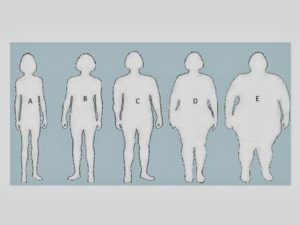Using the Body Mass Index
Body mass index is defined as body weight divided by the square of height. While the BMI has been in existence since the eighteen hundreds, it came to prominence in the early 70’s as concerns about increasing levels of obesity became prominent. While not a perfect measurement, it has been found to be the most accurate of the simple body fat measurements. It’s even easier to use by referring to a table like the one below. Find your height in the left column, and trace horizontally to find your weight. Straight up from your weight, at the top of the chart will be your BMI number.
The BMI scale breaks down as follows a BMI of 19 to 24 is normal weight, a BMI of 25 to 29 is overweight, a BMI of 30 to 39 is obese, a BMI over 40 is extremely obese, sometimes referred to as morbidly obese.
How to Move from Obese to Normal without a Diet
I feel I can fairly answer this question because I was able to move from the obese category to the normal category and have remained there for over a year. Please know that I’ve had my share of yo-yo diets. I’ve lost and regained 30 lbs a half dozen times in my life. Maybe that’s why I decided to do something different. Take a look at what I did.
- Take a vow to never diet again.
- Think about this. How would you eat if you were never going to diet ever again? ·
- Put no time limit on achieving your healthy weight.
- It took me two years to lose 50 lbs. The slower the better. Slower means you’re developing real habits.
- Eliminate hydrogenated oil, high fructose corn syrup, and artificial sweeteners (diet soda) from your diet.
- Make one small change to your diet at a time. Once you’re used to that change, make another small change.
- Commit to eating real food and forget calories; salad and fruit daily, grass fed beef, free range eggs
- Your body wants nutrients, not calories. Again, just make one small change to your diet at a time.
·
- Get the preservatives, GMOs, and toxins out of your diet and the toxic emotions out of your head.
- If you can’t pronounce it or don’t know what it is, don’t eat it. If something is bothering you, deal with it, don’t ignore it.
- Dehydrated Broth – Making It Easy to Drink Broth Every Day! - March 11, 2017
- Lose 10 lbs DURING the Holidays - November 19, 2016
- Finding Good Oils - February 7, 2016




No comments yet.